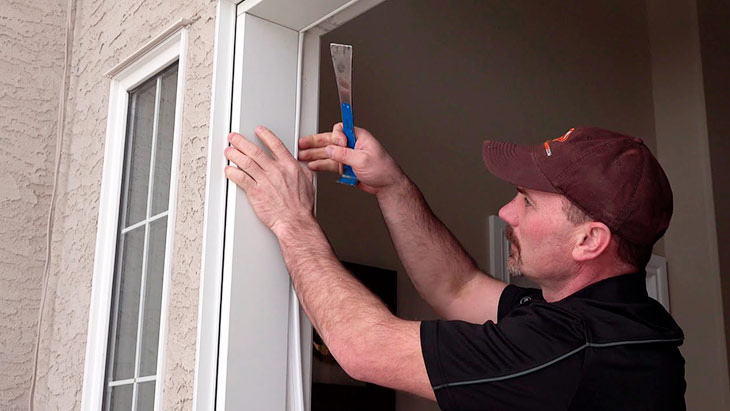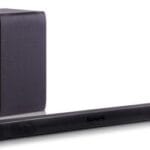Do you often feel a chilly draft sneaking into your home, even when all the windows are shut tight? That pesky air leakage around your door could be the culprit.
Not only does it make your living space uncomfortable, but it also hikes up your energy bills. Imagine the relief of a cozy home and the joy of saving money by simply stopping that draft. In this guide, you’ll discover practical tips to seal your doors effectively.
It’s time to reclaim your comfort and keep your home energy-efficient. Let’s dive into how you can stop air from leaking around your door, and enjoy a warmer, more cost-effective home.

Credit: www.homesolutionsiowa.com
Identify Air Leaks
Stopping air leaks around doors is essential for energy efficiency. Identifying air leaks can save money on heating and cooling. It also enhances comfort indoors.
Understanding signs of air leaks is the first step. Knowing what to look for helps. Detecting leaks can be easy with the right tools and methods.
Common Signs Of Air Leaks
Feel for drafts around door edges. Cold spots near doors indicate leaks. Look for light seeping through door gaps. Listen for whistling sounds when the wind blows. Check for visible gaps or cracks in the frame.
Tools For Detection
Use a flashlight to spot small gaps. A smoke pen helps visualize air movement. Thermal cameras show temperature differences. Hand-held leak detectors can pinpoint leaks. A simple candle test can also be effective.
Weatherstripping Solutions
Weatherstripping solutions are essential for stopping air leaks around doors. They seal gaps and improve energy efficiency. Proper weatherstripping keeps your home warm and reduces energy costs. It’s a simple DIY project that anyone can do. Let’s explore the types and installation guide.
Types Of Weatherstripping
Various types of weatherstripping materials are available. Each has its unique benefits. Foam tape is cost-effective and easy to apply. It suits minor gaps and smooth surfaces. V-strip is flexible and fits irregular gaps. It works well with wooden doors. Door sweeps block air from entering at the bottom. They are ideal for exterior doors. Felt weatherstripping offers a soft option for light sealing needs.
Installation Guide
Installing weatherstripping is straightforward. First, measure the gap to choose the right material. Clean the door frame thoroughly. Dirt can affect adhesion. Cut the weatherstripping to fit the door’s dimensions. Peel off adhesive backing if your material has it. Press firmly along the door frame. Ensure tight contact without gaps. For door sweeps, align them with the door’s bottom edge. Secure with screws or adhesive, depending on the type. Test the door for proper sealing. Adjust as needed for a perfect fit.
Door Sweep Installation
Sealing air leaks around your door can significantly enhance your home’s energy efficiency. A door sweep is a simple yet effective solution. It helps block drafts, noise, and even pests. Installing a door sweep not only keeps your home warm in winter and cool in summer, but it also reduces energy bills. Let’s dive into how you can install a door sweep easily and effectively.
Selecting The Right Door Sweep
Choosing the right door sweep can make a world of difference. You’ll find various types, including bristle, rubber, and vinyl sweeps. Each has its own benefits, so consider your specific needs. For instance, a rubber sweep might be perfect if you’re dealing with uneven floors. On the other hand, bristle sweeps are great for carpeted areas.
Measure your door’s width to ensure a proper fit. A door sweep that’s too short or too long won’t seal effectively. You might want to opt for an adjustable or cut-to-size option for a perfect fit. Think about the material that would best suit your climate and door type. A little research can help you make an informed decision.
Step-by-step Installation
Installing a door sweep is straightforward, and you can do it yourself with a few tools. Start by gathering a screwdriver, a measuring tape, and a pencil. If your sweep needs trimming, a hacksaw or utility knife can do the job.
First, open the door and clean its bottom edge thoroughly. Dirt and debris can prevent proper adhesion. Next, measure the door width and cut the sweep to fit if necessary. Position the sweep against the door, ensuring it touches the floor just enough to form a seal without hindering movement.
Mark the screw holes with a pencil, then remove the sweep and drill pilot holes. This prevents the wood from splitting. Align the sweep with the holes and screw it in place. Check that the sweep moves smoothly over the floor without gaps. Adjust if necessary, and your door is now draft-proof!
Have you ever felt a cold draft on a windy day, even with the door closed? Installing a door sweep might be the small change that makes a big difference. Take action today and improve your home’s comfort and efficiency.

Credit: www.youtube.com
Caulking Gaps
Air leaks around doors can raise energy bills. Caulking is an effective solution. It seals gaps and prevents drafts. This method is simple and affordable. It enhances comfort and efficiency in your home. Learn how to choose the best caulk and apply it effectively.
Choosing The Best Caulk
Selecting the right caulk is crucial. Silicone-based caulks are flexible and durable. They resist moisture and weather changes. Acrylic caulks are easy to apply and paintable. Consider your specific needs. Check for indoor or outdoor use. Read labels carefully. Choose a caulk that suits your environment.
Application Techniques
Start by cleaning the area. Remove old caulk and debris. Ensure the surface is dry. Cut the caulk tube’s tip at a 45-degree angle. Use a caulking gun for precision. Apply steady pressure. Fill the gap evenly. Smooth the caulk with a wet finger or tool. Let it dry completely. Follow drying instructions on the package.
Regularly check for new gaps. Reapply caulk as needed. Proper application prevents air leaks. It maintains your home’s energy efficiency. Enjoy a cozier living space.
Foam Sealant Application
Foam sealant stops air leaks around doors, saving energy and money. Apply evenly along door frames for best results. This simple fix enhances comfort by preventing drafts and keeping indoor temperatures stable.
Foam sealant application is a straightforward and efficient method to stop air from leaking around a door. It involves using foam to fill gaps and cracks that might be letting drafts into your home. This solution is not only easy to apply but also cost-effective, making it a popular choice for homeowners looking to improve energy efficiency.Benefits Of Foam Sealants
Foam sealants offer several benefits that can make a noticeable difference in your home. First, they provide an airtight seal, which helps keep your home warm in winter and cool in summer. This can lead to lower energy bills, as your heating and cooling systems won’t have to work as hard. Second, foam sealants are durable and long-lasting. Unlike other sealing methods, foam can expand and contract with temperature changes, maintaining its effectiveness over time. Plus, foam sealants are resistant to moisture, preventing mold and mildew growth around your door.How To Apply
Applying foam sealant is a simple process that you can do yourself. Start by cleaning the area around the door to remove any dirt or debris. This ensures that the foam will adhere properly. Next, shake the can of foam sealant and attach the applicator nozzle. Insert the nozzle into the gap around your door and press the trigger to release the foam. Move steadily along the gap, ensuring even coverage. Allow the foam to expand and dry, which usually takes about an hour. Once it’s dry, you can trim any excess foam with a utility knife. Applying foam sealant might seem like a small task, but it can significantly improve your home’s comfort. Have you ever noticed a draft and wondered how much energy it’s costing you? A simple foam sealant application could be the solution you’ve been looking for.
Credit: vinyllight.ca
Regular Maintenance Tips
Seal gaps around doors to stop air leaks using weatherstripping. Install a door sweep at the bottom for extra protection. Regularly check and replace worn-out seals to maintain efficiency.
Regular maintenance is the key to preventing air leaks around your door. It not only saves energy but also ensures your comfort during chilly nights. Keeping your door sealed tight doesn’t have to be a hassle. With a few routine checks and knowing when it’s time for a replacement, you can keep your home cozy all year round.Routine Checks
Regularly checking your doors is a simple yet effective way to keep air leaks at bay. Start by inspecting the door frame and weatherstripping every few months. Look for cracks or gaps that might let air slip through. You might find it helpful to use a flashlight to see better in dark corners. If you spot any gaps, it’s time to take action. Feel for drafts by running your hand along the edges of the door. You can also use a lit candle; if the flame flickers, it’s a sign of an air leak. Don’t forget to check the hinges and ensure they’re tight. Loose hinges can misalign the door, creating spaces for air to escape.Signs For Replacement
When should you replace your weatherstripping or door? Keep an eye out for wear and tear. If the weatherstripping is cracked, brittle, or missing, it’s time for a new one. This is often a quick fix that makes a big difference. Notice any visible damage or warping on the door itself? This could indicate it’s not sealing properly. Sometimes, you might hear outside noises creeping in more than usual. This could mean the door’s insulation is compromised. Ask yourself: Is it worth patching up, or is a full replacement a better investment? Balancing cost and efficiency is crucial. Taking these steps will not only make your home more energy-efficient but also more comfortable. Have you experienced any unexpected drafty nights, even after closing the door? Regular checks and timely replacements can prevent that.Frequently Asked Questions
How Can I Tell If My Door Is Leaking Air?
Check for drafts by feeling around the door edges. Use a candle to detect air movement.
What Materials Stop Air Leaks Around Doors?
Weatherstripping and door sweeps are effective materials. They seal gaps and prevent air from escaping.
Does Weatherstripping Work For All Door Types?
Yes, it works for most doors. Choose the right type for your specific door material.
How Often Should I Replace Door Seals?
Replace them every few years. Inspect them regularly for wear and tear to ensure effectiveness.
Can Door Sweeps Be Installed Easily?
Yes, door sweeps are easy to install. They require basic tools and minimal effort for effective sealing.
Conclusion
Stopping air leaks around doors is simple with the right steps. Seal gaps using weatherstripping for an effective fix. Install a door sweep to block drafts from below. Check and replace old caulk around door frames. Use foam tape for extra protection.
Regular checks help maintain energy efficiency. These steps save money on heating and cooling. Enjoy a comfortable home with less noise and fewer drafts. Keep your space cozy and secure. Follow these tips for lasting results. Your efforts ensure a more energy-efficient home.
Stay warm in winter and cool in summer.




